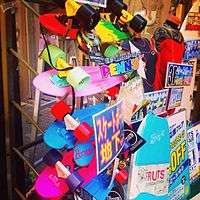Penny board
A Penny board is a type of plastic skateboard, known within the industry as a short cruiser. The term "Penny" is synonymous with "Penny Skateboards", an Australian-based company founded in 2010 by Ben Mackay.[1] Penny is a registered trademark for skateboards, but has been widely genericised to describe all small plastic skateboards due to the brand's popularity. Penny Skateboards pair a plastic deck with cruiser wheels and trucks. This combination now epitomises a "Penny board" in generic terms.
 Penny skateboards on sale at a shop in Shibuya, Tokyo | |
| Type | Skateboard |
|---|---|
| Inventor | Ben Mackay |
| Inception | 2010 |
| Manufacturer | Penny Skateboards |
| Website | www.pennyskateboards.com |
Penny boards are sold in four different deck sizes, the 22 in (55.9 cm), 27 in (68.6 cm) (the Nickel), 32 in (81.3 cm) cruiser and 36 in (91.4 cm) longboard.
History
Some of the earliest plastic skateboards were created in 1978 by Larry Stevenson,[2] a former Venice Beach lifeguard, who developed a line of plastic boards for his brand Makaha. In the 1990s, other plastic skateboard brands such as Stereo Skateboards, Krooked Skateboards and Globe emerged on the plastic skateboard market.
Ben Mackay created the Penny board in 2010, from which the brand Penny Skateboards was born.[3] Penny Skateboards was named after Ben Mackay's sister, Penny. The idea behind the creation of the company was inspired by Mackay’s first ever skateboard, a small plastic cruiser his father bought for him at a garage sale, when he was just five years old.
Ben Mackay first started manufacturing and designing his own skateboards to sell to local skate shops.[4][5] Drawing on woodworking and sales skills handed down from his father, he was determined to fulfill his dream of creating his own skateboard brand. Mackay began experimenting with different shapes and types of boards. He used a variety of materials, such as fiberglass and carbon inserts, as an alternative to timber.
Characteristics
Penny boards are distinguished by a plastic deck, offered in different colours. Penny Skateboards encourages barefoot riding via their social media accounts, particularly during the summer.[6][7]
Partners
Penny Skateboards has partnered up with artists, skaters, and big-name brands. Penny has launched collections detailing their relationship with colorful and unique boards that tailor to their partners. Penny currently has collections with Andy Davis, Star Wars, Burger Records, and Tyler Sprangler.[8]
Transportation
Unlike skateboards which are often used for performing tricks penny boards are usually utilized solely for transportation. Simply riding a skateboard without any tricks is referred to as cruising. Both traditional skateboards and penny boards have a close relationship with transportation, especially transportation to and on university campuses. A United States census found that the highest rates of non-motorized transportation is seen in between the ages 16–24 year-old.[9] Thus it can be reasonably suggested that skateboards, usually penny boards, for various reasons, have an increased presence on large college campuses. Students are seen cruising between classes and resting their boards against the walls of lecture halls. These non-motorized modes of transportation are so popular that according to the California Department of Transportation, travelers such as skateboarders, roller skaters, and scooter users ride nearly 50 million miles per year.[10] Moreover, a survey at University of California, Santa Barbara found that 7% of students skateboard to class compared to the 6% that drive a vehicle to campus.[11] Skateboards are a hugely popular form of transportation, yet many schools maintain policies prohibiting their use on campuses, claiming they are disruptive and harmful to the campus.[12] However, penny boards compact size, convenience, aesthetic, and fun nature are what continue to draw thousands of students to these boards.
References
- Mackay, Ben. "About Penny". Retrieved 27 October 2016.
- Rice, Joel. "THE REBIRTH OF PLASTIC SKATEBOARDS". X Games. Retrieved 15 November 2014.
- Bradstreet, Kailee. "The Board Room: Penny Skateboards Founder Ben Mackay". Transworld Business. Retrieved 22 November 2014.
- "From Skateboard and Longboard to Penny Board (Fall 2102)". Historpedia. Retrieved 22 November 2014.
- Smith, Aaron. "A History Of Penny Skateboards". Skateboarder Magazine. Retrieved 22 November 2014.
- "Penny Skateboards on Instagram: "Time to get outside and let loose #almosttheweekend #pennymoments from @KIAH.L"". Instagram. Retrieved 24 February 2019.
- "Penny Skateboards on Instagram: "Do you push #barefoot in Summer? Thanks @nick._.russell for showing off your new 27" #pennyskateboard"". Instagram. Retrieved 24 February 2019.
- "Penny Skateboards". Penny Skateboards US. Retrieved 14 September 2019.
- Jackson, Brynne M.; Ekins, Taryn E.; Low, Joshua; Chaney, Robert A. (1 July 2018). "Skateboarding Policies on College Campuses in the United States: A Look Toward Promoting Use of Active Transportation". Health Behavior and Policy Review. 5 (4): 30–38. doi:10.14485/HBPR.5.4.4. ISSN 2326-4403.
- Fang, Kevin; Handy, Susan (February 2019). "Skateboarding for transportation: exploring the factors behind an unconventional mode choice among university skateboard commuters". Transportation. 46 (1): 263–283. doi:10.1007/s11116-017-9796-9. ISSN 0049-4488.
- Fang, Kevin; Handy, Susan (February 2019). "Skateboarding for transportation: exploring the factors behind an unconventional mode choice among university skateboard commuters". Transportation. 46 (1): 263–283. doi:10.1007/s11116-017-9796-9. ISSN 0049-4488.
- Jackson, Brynne M.; Ekins, Taryn E.; Low, Joshua; Chaney, Robert A. (1 July 2018). "Skateboarding Policies on College Campuses in the United States: A Look Toward Promoting Use of Active Transportation". Health Behavior and Policy Review. 5 (4): 30–38. doi:10.14485/HBPR.5.4.4. ISSN 2326-4403.
Further reading
- Brooke, Michael (1999). The Concrete Wave: The History of Skateboarding. Warwick Publishing. ISBN 1894020545.